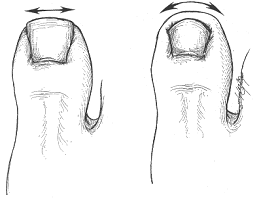Trimming toenails

correct
incorrect
Self treatment
To avoid ingrown toe nails, it is advisable not to cut the nails too short. Patients often believe that it is best to cut toe nails ‘straight across’, this would leave sharp corners of nail which could possibly cut into the adjacent toe. The correct advice would be to cut the nail following the outline of the end of the digit ensuring that when cut the whole of the leading edge of the nail is still visible. See Fig 3. It is preferable to use nail clippers rather than scissors. Scissors have a slicing action which can be painful. In patients who are not confident using sharp instruments, the nail can be shortened using an ‘Emery board’ or abrasive file.
Clinic treatment
Conservative treatment is indicated for all grade 1 presentations and some grade 2. Treatment is restricted to debridement of the affected nail. Some practitioners pack the affected sulcus with cotton gauze; as described by Reijnen and Goris (1989).
If interdigital pressure appears to be an aggravating factor, the use of an interdigital spacer has been reported as successful (Gunal 2003).
Antibiotics are often prescribed for infected ingrowing toenails. While this may be appropriate to control acute symptoms, patients often have further problems and antibiotics should not be seen as a long-term solution. Reyzelman et al (2000) showed that periprocedural antibiotics did not improve the outcome of phenol matricectomy, even if given a week before to allow the infection time to resolve before the main procedure.
